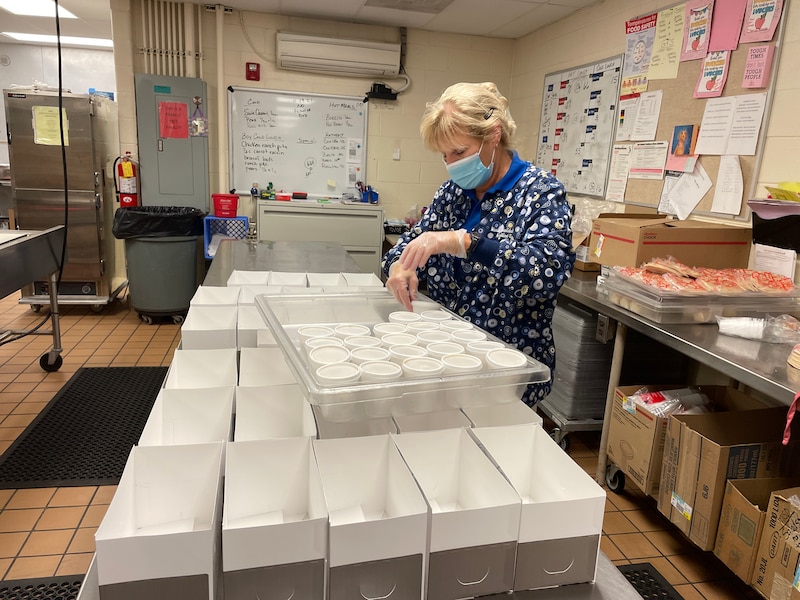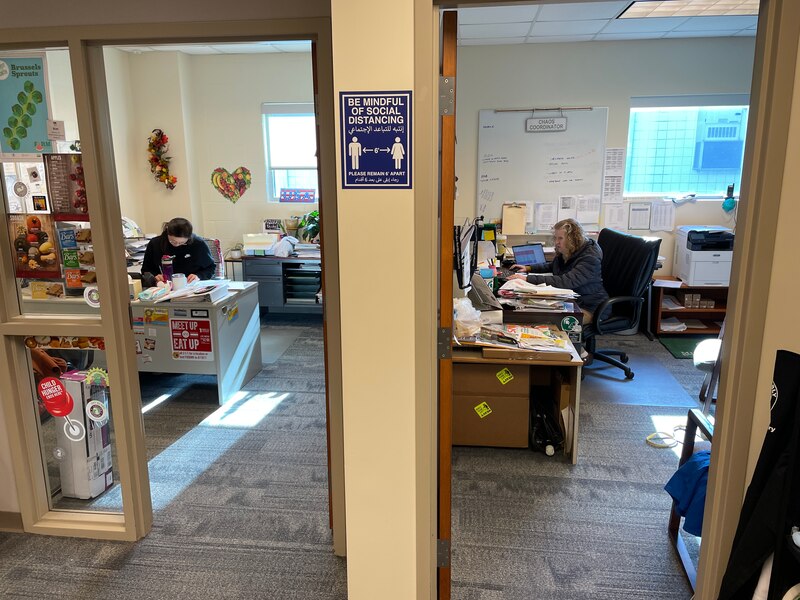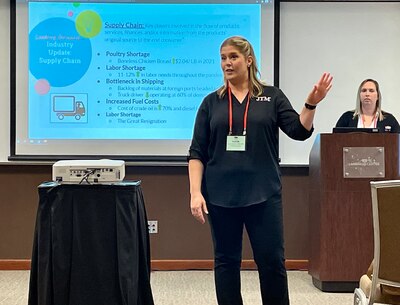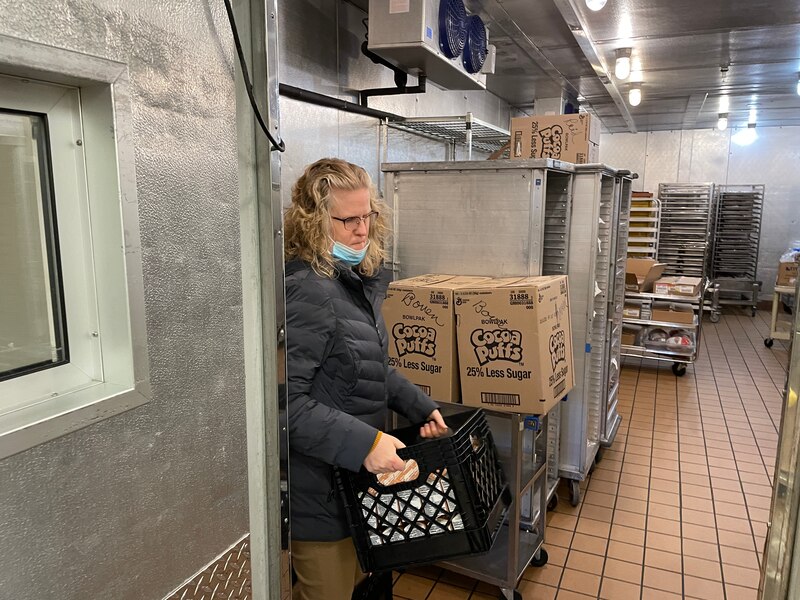It sounded like a losing game of Go Fish.
“I need deli turkey,” Caroline Dylewski said.
“I do not have any sliced turkey,” came the response over the phone.
“Unsliced that I can slice myself? Anything. I just need plain deli turkey,” Dylewski said from her office at Warren Consolidated Schools north of Detroit, where a sign above her cluttered desk reads “chaos coordinator.”
“I didn’t have any yesterday. I’ll have to look,” said Brian Jakubison, the sales representative on the phone from Gordon Food Service.
Salami? Cheese sticks? Chicken drumsticks? Garlic bread seasoning?
No, no, no, and no.
Dylewski isn’t the only food service director struggling to source enough products for school cafeterias in the face of shortages of food to serve, workers to heat it, plates to serve it on, and refrigerators to store it in. The problem is compounded by increases in student demand in many districts since Congress, in response to the pandemic, made breakfast and lunch free for all students this year.
Manufacturers, distributors and shippers are feeling the pinch, too.
“Manufacturers don’t always have enough people to produce the product. If they do, they may not have enough drivers to get it to the distributor, and then the distributor might not have enough people to pick the order or enough drivers to get it to the school,” said Carolyn Thomas, Macomb County schools’ child nutrition consultant.
There’s a problem in every link of the supply chain, said Diane Golzynski, director of health and nutrition for the Michigan Department of Education. “It’s not one single thing. It’s everything all wrapped together,” she said.

In a July survey, 97% of school food service directors across the country said they are concerned about supply chain disruptions and 90% said they were concerned about staffing shortages.
“The frustration is real. I’m worried about the burnout. I’m worried about directors being able to get through this really, really difficult time,” said Lori Adkins, child nutrition consultant for Oakland County schools and president elect of the national School Nutrition Association, which conducted the survey.
Distributors say they’re doing their best to operate amid the challenges.
“Throughout the pandemic, we’ve focused on working closely with customers to address these issues, including identifying appropriate product alternatives or helping redesign elements of the menu,” said Mark Schurman, spokesman for Gordon Food Service, one of the four major suppliers to Michigan school cafeterias. “We’re also searching for additional qualified suppliers and expanding alternative solutions whenever possible,” he said.
Amid worsening staffing and supply-chain problems, schools across the country are struggling to feed students, some of whom rely on cafeterias for most — or sometimes all — of their daily nutrition, and unnourished children have trouble learning.
“When you’re hungry, it’s the only problem you have. Not school, not home, not friends. It’s the only problem,” Golzynski said. “Children who are hungry lose concentration in school and therefore lose out on precious learning time, have lower academic performance, and a lower ability to calm themselves.”
They also have higher rates of illness, depression, suicide, anxiety, and social isolation, she said.
School cafeterias must meet nutritional content requirements to be eligible for federal reimbursement — $4.31 for lunch and $2.26 for breakfast. The U.S. Department of Agriculture recently waived many of those requirements if pandemic-related supply-chain problems prevent districts from meeting them, but districts still must strive to meet nutrition goals.
Schools are sourcing food wherever they can find it. Some are ordering from local bakeries and pizza chains. Others are buying cases of paper cups and carts full of hamburger buns at retail stores. Those with enough staff and kitchen equipment are making meals like macaroni and cheese from scratch.
All of that strains food service budgets. The cost of food has risen 4.6% over the last year and has soared even higher – 10.5% for meat, fish and eggs.
School districts in Michigan have formed buying consortia that give them bulk purchasing power from distributors selected through competitive bidding. Until the pandemic, those distributors almost always had the stock to deliver what districts needed, but now many are forced to buy on the open market, where prices are higher.
“If you’re a district with 600 kids but you’re in a consortium with 600 districts and now there are 700,000 kids you’re going to get much better prices,” Golzynski said.
The U.S. Department of Agriculture recently announced it would provide $1.5 billion in extra food assistance to schools, daycare centers, adult care centers, and emergency shelters. That program is under development. A department spokesperson said it could include direct payments to districts or the USDA purchasing food to distribute to schools.
School food service directors hope it will be enough to balance their budgets.

‘The food we want just isn’t there.’
Apple danish, potatoes, and sausage.
That was among the meals Jamie Phelan’s children were served in the cafeterias at Webster and Roosevelt elementary schools in Livonia.
“I was hearing from the kids that one group would come in for first lunch and they would run out of whatever entree. The kids that were after would get whatever [cafeteria workers] could piece together,” Phelan said.
That’s when she decided to pack backup nonperishable lunches for her children to keep in their classrooms in case they couldn’t find something appetizing in the cafeteria line.
“They had been coming home hungry, which for my kids isn’t a horrible thing because we’re lucky enough to have food in our home. But they do have a few friends who have issues getting food at home” because parents are out of work and struggling to afford groceries that have gotten more expensive during the pandemic, Phelan said. “For some kids the only real meals they have are at school.”
Food service directors are aware of those struggles. That’s why they say they feel extra pressure to do their best. Sometimes that means working late to get food orders in or driving on weekends to grocery stores and food wholesalers in other towns to see what they can find.
“Families have been struggling,” said Jennifer Mattison, director of food and nutrition services for Dexter Community Schools. “There’s need at every socioeconomic level.”
That’s one reason food service directors are grateful for the federal mandate requiring free meals for every student through the end of this school year, even though it means more work for staffs already stretched thin.
“Our goal is to make sure kids are fueled and ready to learn. We want everybody to be on the same playing field and that they’re not having to worry about being hungry,” Mattison said. “Nobody ever has to wonder, ‘Can I get lunch today?’”
They do have to wonder, though, what that lunch might be. Lately, there’s a good chance it won’t be what’s on menus districts distribute weeks in advance.
“Oftentimes, we prepare a menu based on what we ordered,” Livonia’s director of operations Phillip Francis told the board of education at a recent meeting. “We lay that menu out, post it, and then, lo and behold, items aren’t on the delivery.”
Sometimes that means unexpected and unappetizing offerings children won’t eat.
Older students are finding fewer choices than they’re used to in their cafeterias.
Detroit high school students, for example, used to have several entree choices each day but now might have only four, said Carl Williams, director of nutrition for Detroit Public Schools Community District.
“I can’t get all the food that I want, and not being able to give my students that variety of food makes me emotional. I think I’ve cried about two or three times when I left the school and I just don’t see that variety anymore,” he said during a recent conference of the School Nutrition Association of Michigan. “The challenge hurts me.”
‘I’ve never seen this product before.’
Districts with the space stock up on canned vegetables, shelf-stable milk, cases of cereal, and as much ground beef as they can fit in their freezers, but storage space is often limited.
Shortages of mainstays also means a learning curve for cafeteria workers who have to prepare unfamiliar products, said Alison Powers, a Midwest regional sales representative from G.T.M. foods during a presentation to food service workers last month at the School Nutrition Association of Michigan’s annual conference.
“You guys are getting stuff on your trucks that you’re like, ‘I’ve never seen this product before. What in the world do I do with it?’” Powers said. “It’s more work. It’s a lot more work, I know.”

That’s why distributors like JTM Food Group are providing recipes and suggestions for using one ingredient multiple ways. Mixing taco meat with macaroni and cheese, for example, creates a whole different menu item, she said. Adding tomato paste and seasoning turns the same meat into spaghetti sauce or chili.
That means extra work for cafeteria staff.
One recent week neither of Warren’s usual suppliers had the individually wrapped cheese sticks or cheese cubes ordered for elementary schools.
“There’s nothing. No cheese cubes. No string cheese. No cheese sticks,” Wen Guo, supervisor of nutrition services, told Dylewski.
She had to order blocks of cheese instead.
That would mean cafeteria workers would have to cut it into cubes and wrap them individually so students could serve themselves without handling other food. The plastic wrap they use is in short supply,, but Dylewski had stocked up a few weeks earlier when she was able to find some.
Bowls, plates, trays, forks, cups, and spoons are hard to find, too.
At a recent lunch meeting of school food service directors, one desperate attendee made the rounds to collect unused utensils to take back to her school.
“One of the biggest challenges for us this year is trays. We have to have something to put the food on, and we can’t get our normal school lunch tray that’s disposable,” Mattison said. “Every school district is struggling.”
Those with dishwashers have started using hard plastic trays or paper-lined baskets that delis sometimes use for sandwiches and fries. That means an extra strain on staff too because someone has to wash them.
And if equipment breaks, repairs could take weeks or even months.
“Equipment is getting used more, so it’s wearing out faster and breaking down more, and you can’t get the parts to fix it,” said Joe Plume of Town Center HVAC-R, a Howell, Mich. company whose customers include school districts. “We don’t have parts in stock, the manufacturers don’t have any, and they don’t know when they’re going to get them.”

“Quick … before it disappears.”
Every solution seems to create another problem, food service directors said.
Jakubison tries to help with food supply issues by alerting the districts he services when a hard-to-get item they usually order becomes available, but they have to act fast when it’s in Gordon Food Service’s online ordering system. Otherwise another district will snatch it up.
“I’m telling you right now, this stuff is posted and within minutes it’s gone. I’ve never seen anything like what is happening. It’s incredible. And no one’s hoarding. That’s the crazy part, too,” he told Dylewski on a recent order day after he helped her find small plastic cups to serve yogurt parfaits.
“It’s like a game, Dylewski said.
“Hey, quick, what about this salami before it disappears?” she asked Jakubison as she skimmed an email he sent her earlier listing in-stock items she might want to order.
“There’s two good sliced ones there,” he told her, then gave her the product numbers so she could check the price and nutrition content online.


